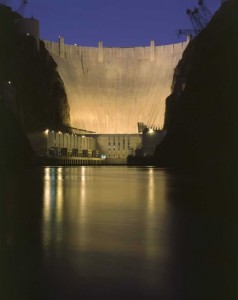John Cochrane, meet the Hoover Dam
I wonder if some economists, like some meteorologists, ever look out the window at the real world. Most of the time, there’s a lot of saltwater-vs.-freshwater-school-of-economics sniping going on, especially in the current crisis. Not much practical work is being done and the Chicago/freshwater economist folks are particularly obtuse. One of the most frustrating things is their claims that make no sense to me, especially when they fail to look at concrete examples that prove them wrong. There is no more concrete example (pardon the pun) than the Hoover Dam.
UC Berkeley economist Brad Delong, who looks out his window at Berkeley’s baristas and yoga instructors and also recognizes the value of government investment, wrote in his blog the following quote from John Cochrane, of the University of Chicago. “Most fiscal stimulus arguments suffer from three basic fallacies. First, if money is not going to be printed, it has to come from somewhere. If the government borrows a dollar from you, that is a dollar that you do not spend, or lend to a company to spend on new investment. Every dollar of increased government spending must correspond to one less dollar of private spending. Jobs created by stimulus spending are offset by jobs lost from the decline in private spending. We can build roads instead of factories, but fiscal stimulus can’t help us to build more of both. This is just accounting, and does not need a complex argument about ‘crowding out’…”
Cochrane may have his points if he’s talking about AIG-type Wall Street bailouts, where much of the public’s bail out money never seems to make it out of the financial sector, but economists should specify the difference between government investment vs. financial-sector handouts, rather than lumping everything together under the generic heading of ‘stimulus.’ Clearly, while the TARP bailout saved the financial sector from disastrous collapse, it did little for most of the American economy, though it preserved a large segment of the auto industry. Contrast that with a productive government- stimulus investment. Thanks to a 1933 Fortune article, we have an excellent historical perspective on such a project along with some interesting statistics.
The Hoover Dam and its associated power and irrigation projects cost $165 million in 1933 dollars and created 16,000 jobs at the height of the Depression. Interest charges during construction were $17 million. Total cost was $1.25 for every man, woman and child in America, which Dr. Cochrane would dismiss as interfering with free enterprise and stealing jobs and capital from the private sector. In reality, the dam cost citizens nothing: the $1.25 actually represents a collective (oops…nasty socialist word) investment by the entire citizenry. In less than 50 years, the dam paid itself off by selling water and power with a 100% profit and continues to generate over $400 million a year from selling electricity.
No doubt Cochrane and cohorts like Congressman Ryan would dismiss this as a mere blip in the GDP, not worth the surrender of ideological positions. But the Hoover Dam’s impacts go far beyond just the project itself and influenced the entire future of the country. It provides irrigation for 3.5 million acres of crops in Arizona, Nevada and California and Mexico, producing >$1.5 billion in crops (providing both nutrition and tax revenues), plus countless thousands of jobs not only in agriculture but all the associated industries like farm machinery. It supplies a billion gallons of water a day to Los Angeles. Hoover Dam electricity powered the rise of the Southern California aircraft industry that did so much to win WWII.
Countless other government programs have generated huge returns and improved the country, such as the Rural Electrification Administration, the WWII GI bill, and a host of other examples of public investments. Which brings us back to the problem with a lot of economists. As a 1991 American Economics Association study put it, economics programs are producing “too many idiots savants, skilled in technique but innocent of real economic issues.” Far too many have studied economics with the intention of moving to Wall Street, as told amusingly by Michael Lewis in his book Liars Poker, in which he reveals that 40% of Yale’s class of ’86 applied for work at one investment bank, First Boston, which became a major player in the sub-prime mortgage debacle.
No economic philosophy or formula will provide certainty for the future, but one that says that ‘We the people,’ acting together through our government, can’t make a collective investment for the betterment of the country seems not only totally wrong-headed but disastrous for our future.

